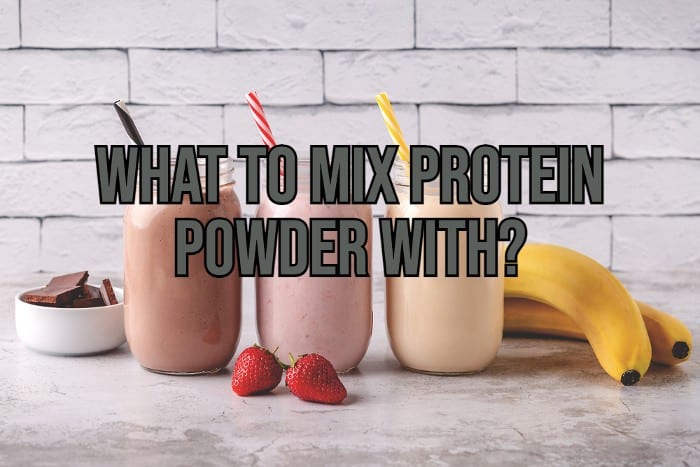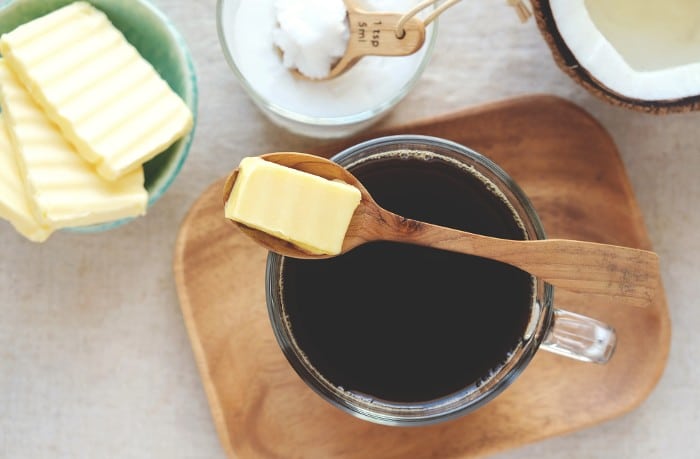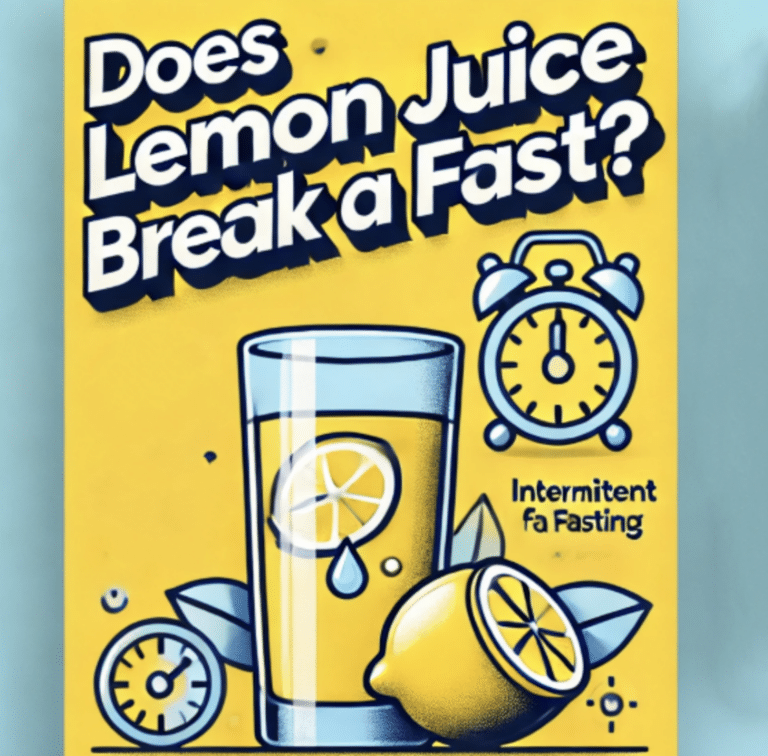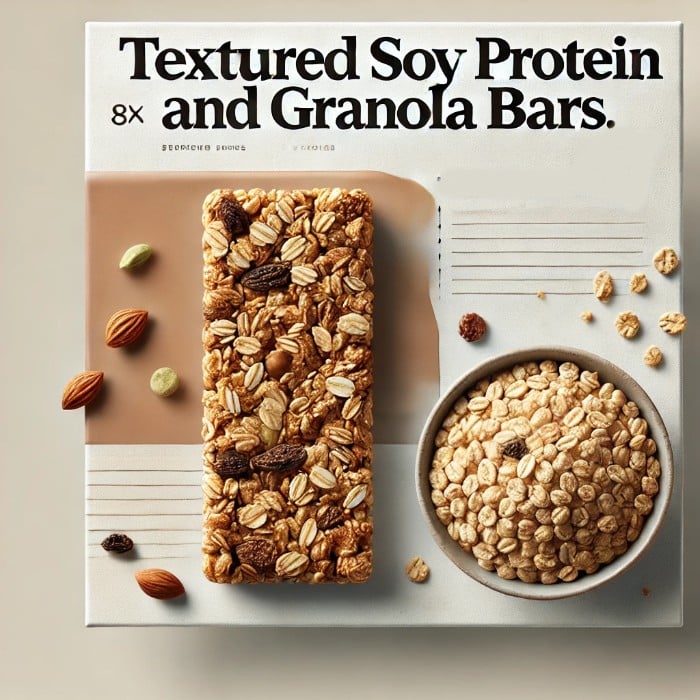What To Mix Protein Powder With?
Are you looking to start making some serious gains in the gym?
Maybe you’re just trying to take your workouts to a whole other level or just shed a few unsightly pounds.
Whatever your goals may be, supplements can play a key role in any healthy living regime, along with diet and exercise.
Suppose you are looking to build muscle or simply tone up, for example. In that case, you’ll find that increasing your protein intake is an extremely beneficial way of getting calories into your body.
Protein is essential for muscle growth and recovery.
This is why bodybuilders and strength athletes tend to follow high-protein diets.
For anybody looking to build muscle, however, you can only eat so much chicken, fish, meat, and eggs in a day. This is where supplements such as protein powders prove to be so useful.
But what exactly is a protein powder, and have you ever wondered what to mix protein powder with?
Firstly, What Exactly Is Protein Powder?
For the body to function as it should, it requires, among other things, three macronutrients. These are carbohydrates, fats, and protein.
Of these three macros, protein is arguably the most important as it plays the most important role in such a wide range of physiological processes inside our bodies.
Our cells need protein to work and function as they should, along with our major organs.
Our muscles also need protein as it facilitates protein synthesis and allows the body to rebuild and strengthen existing muscle tissue.
That’s all well and good, but what does this have to do with protein powder?
Well, protein powder is a high-protein health supplement designed for people looking to increase their protein intake, which makes protein powder so expensive.
There are many different types of protein powder, though the following are the most common, and the most popular:
- Whey protein concentrate or Isolate
- Hydrolyzed whey protein
- Casein protein
- Collagen protein
- Pea protein
- Hemp protein
- Soy protein
- Brown rice protein
- Egg white protein
Of the proteins listed above, and many more besides, it is whey protein concentrate that is the most popular protein powder supplement currently on the market.
These powders are dried and usually flavored and can be added to soups, smoothies, and liquids in general for a quick, easy, high-protein fix.
How Are Protein Powders Made?

Before we do that, however, we need to look at how protein powders are made.
Different protein powders come from different sources, so of course they’re made differently. The main protein powder we’ll focus on today is whey, so let’s learn how it is made.
Whey protein comes from cow’s milk. It is a derivative of milk and is a by-product of when milk is turned into cheese.
When enzymes such as rennet are added to milk to make cheese or cottage cheese, they cause the milk to curdle and separate.
As it splits, it forms solid cheese curds and leaves a yellow-colored liquid called whey. This is where the majority of whey protein comes from.
This high protein liquid is collected, gently pasteurized to make it safe, and is then filtered and processed before being freeze-dried and powdered.
Now, other ingredients may be added to the powder such as flavorings, colorings, and amino acids.
Finally, the protein powder is bagged up or packaged up, labeled, and then shipped off to gyms, supplement stores, health stores, grocery stores, and any other places where you can buy protein powder.
What To Mix Protein Powder With
As mentioned, if you’re looking for a quick, easy, and convenient hit of protein, with minimal effort and prep required, a protein powder supplement is perfect.
Whereas protein powders are useful, tasty, and easy to consume, some people wonder what to mix theirs with. In truth, you can mix protein powder with anything edible, but that doesn’t mean that you should.
To get the most from your protein powder supplements, it pays to know what to mix them with, and what to avoid.
Before you pick up a tub for yourself, check out the following suggestions.
Water
Most gym-goers and fitness fans who use protein supplements will typically mix them with water.
Water is a great choice for mixing your whey protein shakes because it assists with digestion and absorption. Whey protein is a fast-digesting, rapid-absorbing protein that is perfect for consuming immediately after a workout.
When you finish training, the cells in your muscles are simply screaming out for protein and nutrients, which is why a whey protein shake consumed post-workout is so beneficial.
The reason why you should mix it with water is that water is thinner than milk and therefore allows the protein to be digested and absorbed much faster than if it was mixed with milk or another thicker liquid, or one which contained more sugars.
Not only that, but water is incredibly good for the body and can assist with proper hydration for the muscles, organs, and the body in general.
Dehydration can not only leave you feeling unwell, but it can also affect your athletic performance, which is the last thing you need while working out.
You can also mix protein powder with creatine for better results!
Milk
As whey protein, casein protein, and some other forms of protein are derived from cow’s milk, it would make sense to mix protein powder with milk, right?
Milk is one of the most popular liquids that people choose to mix their whey protein powder with and for good reason.
Milk is creamy and rich, it has a great taste and texture, and it is also a great source of calcium, and has been found to contain extra protein as well.
If you like your protein shakes a little creamier and richer, mixing them with milk is the way to go.
Just be aware that this will increase the amount of calories you consume, so if you are trying to lose weight, make sure you factor the extra calories into the equation.
Another possible downside to mixing your protein powder with milk is the fact that the milk will take longer to digest and break down than water, meaning that the protein won’t be absorbed into your muscle cells as quickly.
This is why you shouldn’t mix a post-workout protein shake with milk; the idea here is to get the protein into your muscles as quickly as possible.
Most people will enjoy a protein shake with milk between meals so that the protein stays in their system longer.
A whey protein shake mixed with milk before bed, for example, is generally a good idea.
If you are worried about the extra calories in milk, either use skim milk or use half milk and half water.
Greek Yoghurt
When people wonder what to mix with protein powder, usually they’ll focus on liquids and drinks, rather than whole foods.
Protein shakes generally taste like milkshakes, so you can understand why that is, but liquids aren’t your only option.
A lot of people who use protein supplements will mix their protein powders with Greek yogurt instead of a liquid, or as well, and if you try it for yourself, you’ll instantly know why that is.
One of the main reasons why people mix their protein powders with Greek yogurt or Greek-style natural yogurt is because it gives a thick, pudding-like texture that works incredibly well as a low-carb, high-protein dessert or pudding.
Greek yogurt is packed full of protein, as well as minerals such as calcium, magnesium, zinc, and iron.
It is also rich in healthy fats which help improve cardiovascular health and brain function, while also keeping you feeling full for longer.
If you are dieting, or are simply looking to keep your fat intake low and your calories down, you can always go ahead and go for a reduced-fat or fat-free Greek yogurt to mix your protein powder with.
If you do that, however, the final product won’t be as rich or as creamy, though it’ll still be delicious, just low in calories.
For anybody that is lactose intolerant, or who is allergic to dairy, just be aware that Greek yogurt is of course made from dairy products, and also happens to contain lactose. There are lactose-free options and reduced lactose versions for you to consider, however.
Eggs
Now, before we go any further, we need to make sure that you know that there are flavorless protein powders out there, and it is these that you should use if you wish to mix your protein powder with eggs.
Strawberry-flavored, or chocolate-flavored scrambled eggs do not taste good, trust us on this.
If you want to increase your protein intake, perhaps in the morning for breakfast, go ahead and mix up your scrambled egg mixture, and use a little bit more liquid when you add the powder, until the texture is where you want it to be.
Eggs are packed full of protein and are not only a complete protein (meaning that they contain all essential amino acids needed by the body) but they also contain all non-essential amino acids as well.
Add to this, the brain-boosting choline, vitamin D, and other nutrients found in eggs, and you can see why so many people looking to get in shape consume so many eggs each day.
A typical egg contains around 4g – 6g of protein so a 3-egg scramble would contain less than 20g of protein.
Add a scoop, or even half a scoop, of protein powder, however, and you can bump the protein content up to over 30g per serving.
If you are concerned about calories, go with 1 whole egg and 2 egg whites as it is the whites that contain the protein, whereas the yolks contain healthy fats and good cholesterol.
Coconut Water
If you’re like Eddie ‘The Beast’ Hall, there’s a good chance that you struggle to stay hydrated. Staying hydrated is not essential when it comes to everyday health, it’s also vital in terms of athletic performance as well.
If you’re wondering what to mix protein powder with, and you’re looking to stay hydrated, coconut water is the perfect liquid medium.
Packed full of beneficial electrolytes as well as other minerals, B vitamins, and healthy ingredients, coconut water is the ultimate liquid for people looking to enjoy maximum hydration.
Because of its high electrolyte content, some countries even use coconut water in IV drips for medical procedures.
Mixing your protein powder with coconut water before you train, or during, is a great way to keep your muscles topped up with beneficial protein and amino acids, while also keeping them hydrated when training.
If you want some extra energy and a richer, creamier taste and texture, you can go ahead and switch the coconut water to coconut milk.
This is rich in healthy fats including medium chain triglycerides (MCTs) which the body uses for energy right away and gives the protein shake a richer, more luxurious, and decadent taste and texture.
A word of warning for coconut milk that comes in a can, however, is that the milk will likely be a partially solid block, with the fats separate from the water.
Unless you are tipping it into a blender with the protein powder you will struggle to mix it.
Chocolate Milk
Remember how, several years ago, reports started circulating, talking about how it could be more beneficial to drink chocolate milk after a workout than drinking a protein shake?
Now, while the findings did point to the fact that whey protein supplements were indeed better for post-workout nutrition than chocolate milk, the chocolate milk theory had some legs to it.
Drinking chocolate milk after lifting weights did help to create an insulin spike needed to shuttle more nutrients into the muscle cells, and it also contained more protein than water.
To get the best of both worlds, however, more and more people have started to drink a post-workout shake made with whey protein powder and chocolate milk, and they’ve had good results too.
Not only is this higher in protein, but, come on, it’s chocolate milk, and who wouldn’t want to drink that?
You can either mix a chocolate flavor protein powder with it for the ultimate chocolate hit, or you can even try different flavors that work well with chocolate, such as vanilla, cookies and cream, banana, etc.
The sugar in chocolate milk is not only useful for creating a post-workout insulin spike, but if you start drinking it before your workout, you’ll find that it gives you more energy for training as well.
The main downside, of course, is the fact that it is rich in fat and high in calories, so if you are cutting weight or watching your calories, it may not be suitable.
Apple Juice
Another option! who don’t like the taste of typical protein powders, apple juice mixed with unflavoured protein powder is a great alternative.
Needless to say, mixing flavorless protein powder with apple juice will give you a protein shake that tastes just like apple juice.
The only slight difference is that the texture might be a little bit chalky. Assuming you like the taste of apple juice, however, this is the perfect liquid to mix your protein with.
Apple juice does contain natural fructose sugars so there are more calories in it than water alone, but you can use this to your advantage if you consume it before or during training, as the sugar will give you more energy.
Having the apple juice shake after your workout, however, is also beneficial because the naturally occurring fructose sugars found in the apple juice will help spike insulin levels and get those proteins and amino acids into your muscle cells quicker.
If you struggle to gain weight and want to add some extra muscle mass, apple juice with protein powder is the perfect alternative as it contains extra calories, without being anywhere near as high as something like chocolate milk, or coconut milk.
Smoothies
Okay, this next example isn’t the most detailed because you can put whatever you like into smoothies, within reason of course.
Nevertheless, if you are on the lookout for something different to try, how about a smoothie?
Smoothies are very useful and very healthy for people who struggle to get enough nutrition daily.
You can add whatever you like to a smoothie, though generally, people will use things such as oats, bananas, spinach, frozen berries, blueberries, flax seeds, spirulina, wheatgrass, peanut butter, chia seeds, etc.
Adding a scoop of protein powder to your smoothie is a great way to bump up the calories, and possibly improve the taste as well.
If you have a smoothie with plenty of frozen and mixed berries for example, strawberry or raspberry flavours will work very well.
If you are worried about the taste, however, you can simply go with an unflavoured protein powder.
In any event, a smoothie made with protein powder is not only high in protein, but will also be packed full of fiber, vitamins, minerals, and other nutrients that give the body a world of good.
Almond Milk
Some people prefer not to drink dairy, while others cannot due to allergies intolerances, or even dietary choices.
If you can’t consume dairy, but you want something rich and creamy to mix your protein powder with, almond milk is perfect.
Almond milk is of course made from almonds and is completely plant-based.
If you follow a plant-based diet such as veganism, almond milk is the perfect liquid to mix your protein powder with.
Needless to say, you wouldn’t be able to consume whey, casein, or any other protein powder derived from animals but you could go with a vegan protein blend or something like brown rice, pea protein, or hemp protein powder.
Almond milk contains calcium, zinc, manganese, copper, potassium, iron, and other minerals, plus it is high in protein and low in carbs.
Some almond milk, however, is sweetened so if you do opt for sweetened almond milk, make sure you check the sugar and calorie contents before you make up your protein shake.
Gatorade
If you feel like you need an extra boost of energy when training, mixing your protein powder with Gatorade before or during a workout is going to help.
If you want to stay hydrated and keep your calorie intake low in the process, Gatorade Zero, mixed with an unflavoured protein powder is the way to go.
Not only will this hydrate you and give you a burst of electrolytes, but it also tastes nice fruity, and refreshing.
If you do need the energy boost, go with a regular Gatorade that is high in sugar and will therefore help get you through even the most grueling of workouts.
Final Thoughts
Okay, so, for anybody wondering what to mix protein powder with, hopefully now you’ve got a few more ideas for the next time you feel like a high protein boost.
Different protein powders have different tastes, textures, and nutritional profiles so be sure to choose flavors and textures that complement each other.
While protein supplements are no substitute for whole foods, if you supplement a healthy diet with a good quality protein powder, you’ll soon be reaping the rewards.






